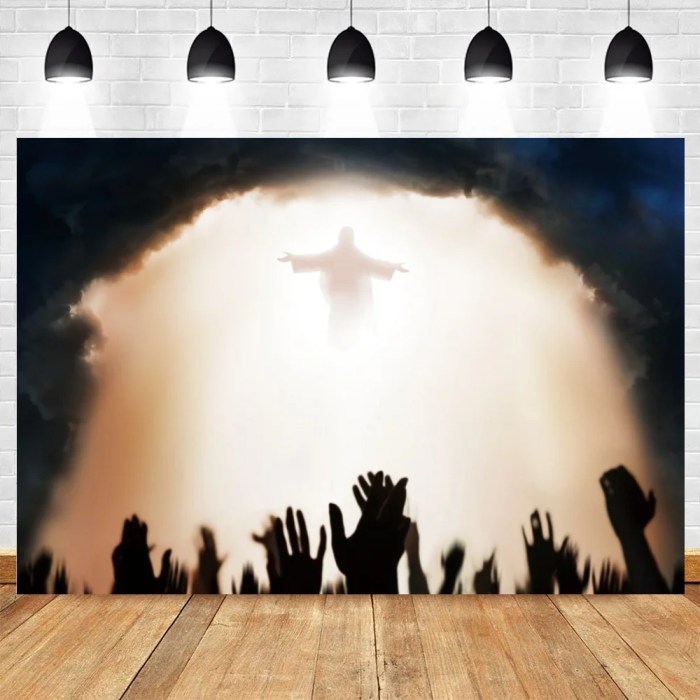Religious Easter Decorations: From ancient traditions to contemporary interpretations, the symbols and artistry surrounding Easter celebrations hold deep cultural and religious significance. This exploration delves into the historical roots of common Easter decorations, examining the symbolism embedded within crosses, lambs, eggs, and specific color palettes like purple, white, and gold. We’ll traverse regional variations across different Christian denominations, showcasing how these decorations evolve across time and geography.
The journey also encompasses modern interpretations, featuring innovative uses of materials and techniques, and the enduring role of these decorations in transmitting cultural heritage and fostering interfaith dialogue.
We will analyze the evolution of Easter decorations, highlighting how modern artists and designers continue to incorporate religious symbolism into contemporary styles. Examples will range from recycled materials to digital art, demonstrating the adaptability of these traditions. A detailed comparison of Easter celebrations across various countries will further illuminate the diversity and richness of these practices, revealing how shared symbols take on unique expressions in different cultural contexts.
Modern Interpretations of Religious Easter Decorations

The traditional imagery of Easter—bunnies, chicks, and pastel colors—has evolved significantly, incorporating contemporary artistic styles and a renewed focus on the religious symbolism of the holiday. Modern interpretations retain the core message of Easter while embracing innovative materials and techniques, resulting in decorations that are both visually striking and theologically meaningful. This shift reflects a broader trend in religious art, where traditional forms are reimagined to resonate with a contemporary audience.
Modern artists and designers are increasingly incorporating religious symbolism into Easter decorations in subtle yet powerful ways. Instead of relying solely on overt representations like crosses or lambs, they utilize more abstract and symbolic forms. For instance, the use of light and shadow, or the incorporation of natural elements like blooming flowers, can subtly allude to the themes of resurrection and new life central to Easter.
The minimalist aesthetic, popular in contemporary design, is also finding its way into Easter decorations, with simple, geometric shapes and muted color palettes used to evoke a sense of serenity and contemplation.
The Use of New Materials and Techniques in Religious Easter Decorations
Contemporary Easter decorations showcase a remarkable diversity of materials and techniques. Recycled materials, such as repurposed wood, glass, and fabric scraps, are increasingly favored, reflecting a growing environmental consciousness. This sustainable approach aligns with the themes of renewal and rebirth inherent in Easter. Digital art is also playing a significant role, allowing for intricate designs and personalized creations. 3D printing, for example, enables the creation of highly detailed religious symbols and figures, offering unparalleled flexibility in design and customization.
Furthermore, techniques like decoupage and mixed-media art are used to create unique and layered Easter decorations that blend traditional and modern aesthetics.
Three Unique Religious Easter Egg Designs
The following designs demonstrate how religious symbolism can be incorporated into contemporary Easter egg decorations:
Design 1: The Radiant Cross
This design features a simple white egg adorned with a subtly embossed cross created using a fine-tipped embossing tool. The cross is not overtly dominant but serves as a quiet reminder of faith. The egg is then delicately painted with iridescent acrylic paints, creating a radiant glow that symbolizes the resurrection. The materials used are a plain white egg, an embossing tool, and iridescent acrylic paints.
The technique involves careful embossing followed by precise painting to achieve a luminous effect. The symbolism lies in the understated yet powerful presence of the cross, enhanced by the radiant glow representing divine light.
Design 2: The Blooming Garden
This design uses a dark brown egg as a canvas, representing the earth before the resurrection. Delicate watercolor paintings of wildflowers and sprouting plants are applied to the egg, symbolizing new life and growth. The flowers are painted in vibrant colors, creating a striking contrast against the dark background. The materials used include a dark brown egg, watercolor paints, and a fine-tipped paintbrush.
The technique involves careful watercolor application to create a realistic and vibrant floral scene. The symbolism is drawn from the contrast between the dark egg (representing the earth) and the vibrant flowers (representing new life springing forth).
Design 3: The Abstract Dove
This design uses a light blue egg to represent the sky. A stylized dove, representing the Holy Spirit, is painted onto the egg using a minimalist approach. The dove is rendered in shades of white and gray, using a technique that combines acrylic paints and subtle shading to create a three-dimensional effect. The materials include a light blue egg, white and gray acrylic paints, and fine brushes.
The technique involves layering paints to create depth and shadow, resulting in a contemporary and abstract representation of the dove. The symbolism focuses on the purity and peacefulness of the Holy Spirit, conveyed through the abstract and minimalist design.
Religious Easter decorations serve as powerful reminders of faith, cultural heritage, and the enduring spirit of Easter. Their evolution reflects changing artistic sensibilities and technological advancements while retaining core symbolic meanings. By understanding the history and symbolism behind these decorations, we gain a deeper appreciation for the rich tapestry of Easter traditions and their capacity to bridge cultural divides and promote interfaith understanding.
The vibrant expressions of faith found in these decorations continue to inspire and connect communities worldwide, ensuring that the spirit of Easter remains a vibrant and meaningful celebration for generations to come.